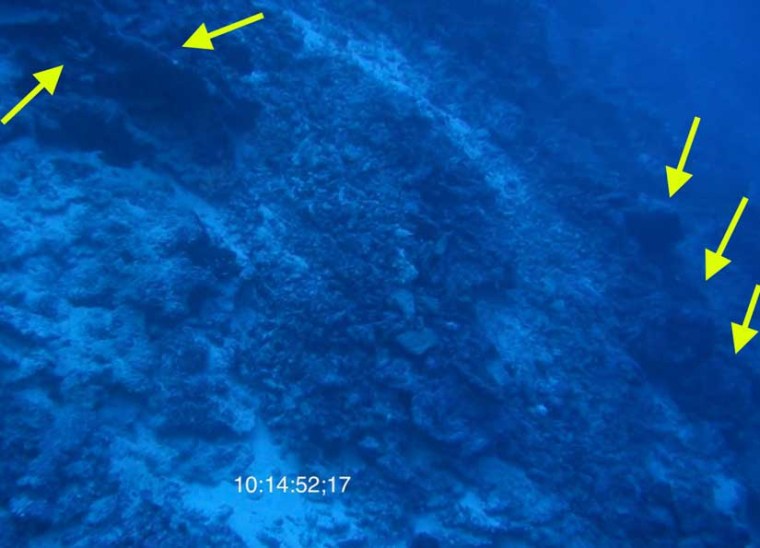Pieces of Amelia Earhart's plane may have been located in the depths of the waters off Nikumaroro island in the southwestern Pacific republic of Kiribati, according to a preliminary review of high-definition video taken last month at the uninhabited coral atoll believed to be Earhart's final resting place.
Carried out by The International Group for Historic Aircraft Recovery (TIGHAR), which has long been investigating the last, fateful flight taken by Earhart 75 years ago, the underwater search started on July 12 and relied on a torpedo-shaped Autonomous Underwater Vehicle (AUV) and a Remote Operated Vehicle (ROV).
The AUV collected a volume of multi-beam and side-scan data, while the ROV, capable of reaching depths of 3,300 feet, produced hours upon hours of high-definition video.
PHOTOS: Amelia Earhart's Fate Reconstructed
Plagued by a number of technical issues and a difficult environment, the hunt did not result in the immediate identification of pieces from Earhart's Lockheed Electra aircraft.
"Early media reports rushed to judgment in saying that the expedition didn't find anything," Ric Gillespie, executive director of TIGHAR, told Discovery News.
"We had, of course, hoped to see large pieces of aircraft wreckage but as soon as we saw the severe underwater environment at Nikumaroro we knew that we would be looking for debris from an airplane that had been torn to pieces 75 years ago, Gillespie said.
As they returned from the data collection trip at the end of July, TIGHAR researchers begun reviewing and analyzing all of new material recovered from the site.
TIGHAR's findings are detailed in "Finding Amelia Earhart: Mystery Solved?" a Discovery Channel documentary that airs Sunday at 10 PM ET/PT
"I have thus far made a cursory review of less than 30 percent of the expedition's video and have identified what appears to be an interesting debris field," TIGHAR forensic imaging specialist Jeff Glickman told Discovery News.
Located distinctly apart from the debris field of the SS Norwich City, a British steamer which went aground on the island's reef in 1929, the site contains multiple objects. Several appear consistent with the interpretation made by Glickmann of a grainy photograph of Nikumaroro's western shoreline.
Shot by British Colonial Service officer Eric R. Bevington in October 1937, just three months after Amelia's disappearance on July 2, 1937, the photo revealed an apparent man-made protruding object on the left side of the frame.
Forensic imaging analyses of the picture found the mysterious object consistent with the shape and dimension of the upside-down landing gear of Earhart's plane.
"The Bevington photo shows what appears to be four components of the plane: a strut, a wheel, a worm gear and a fender. In the debris field there appears to be the fender, possibly the wheel and possibly some portions of the strut," Glickman said.
Recovering the objects is TIGHAR's next goal.
"If further analysis continues to support the hypothesis that we have found the object that appears in the 1937 Bevington Photo, we'll certainly want to recover it," Gillespie said.
Meanwhile, a parallel investigation into a little jar recovered on Nikumaroro in a previous expedition might provide further circumstantial evidence that Amelia Earhart and navigator Fred Noonan made an emergency landing on the island's flat coral reef and eventually died there as castaways.
NEWS: Earhart's Anti-Freckle Cream Jar Possibly Found
"Scientists have found traces of mercury on the interior surface of the little jar that we suspect once contained Dr. Berry's Freckle Cream," Gillespie said.
The new round of testing was prompted by Greg George, a chemist who read Discovery News story on the cosmetic jar.
The purpose of mercury in ointments was for bleaching the skin. Indeed, Dr. C. H Berry's Freckle Ointment was marketed in the early 20th century as a concoction guaranteed to make freckles fade.
"It is well documented that Amelia had freckles and disliked having them," Joe Cerniglia, the TIGHAR researcher who first spotted the freckle ointment as a possible match, told Discovery News.
"The only product sold in the ointment jar that we know contained mercury was Dr. C.H. Berry's Freckle Ointment. Documentation I collected shows this product historically contained anywhere from 9.8 to 12 percent ammoniated mercury, depending on the year it was produced," Cerniglia said.
TIGHAR admitted it is not possible to link the ointment pot directly to Amelia Earhart.
"We can not exclude the possibility that someone brought a jar of American women's freckle cream to a British-administered island where nobody had freckles — but it doesn't seem very likely," Gillespie said.
The jar was found broken in five pieces and one of the fragments was collected far from the others amongst some turtle bones.
"It shows signs of having been used as a cutting tool -- so the jar does seem to have been associated with the castaway who died there," Gillespie said.
"The question, therefore, would seem to be whether the castaway who had a jar of American women's freckle cream was someone other than Amelia Earhart. We don't know who that would be," he added.
